Ecommerce Marketing Automation Strategies to Boost Revenue
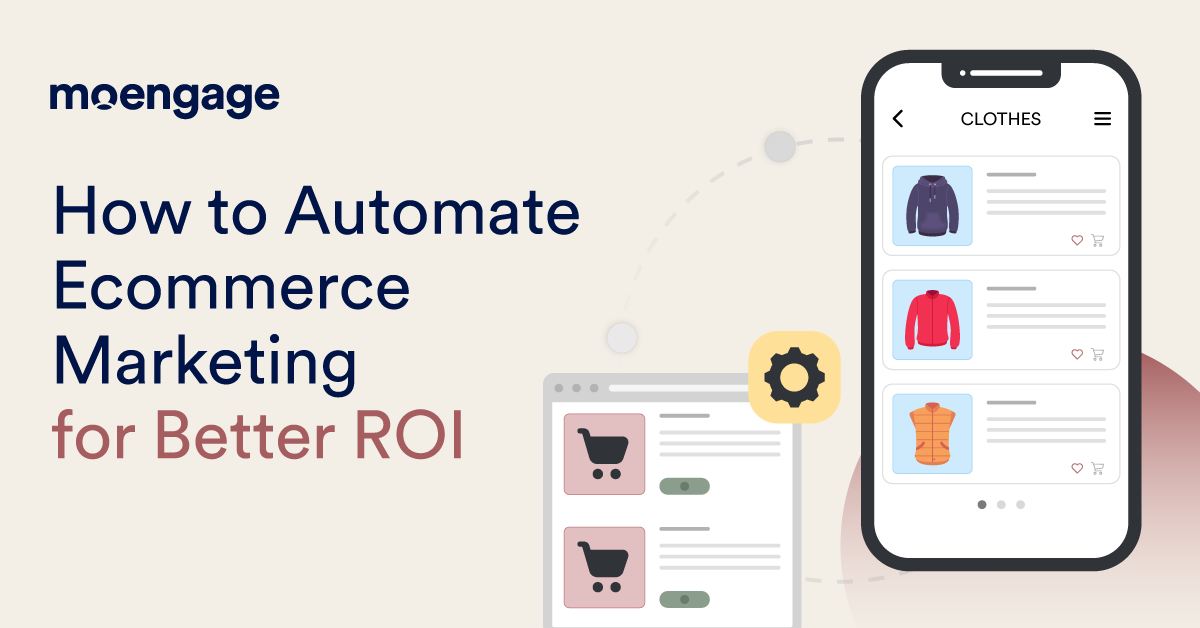
Reading Time: 15 minutes
If you’ve been in the Ecommerce game longer than ten minutes, you’ve probably noticed a pattern: every marketer under the sun is obsessed with finding the perfect Ecommerce marketing automation software platform.
And honestly? They’re not wrong.
Standing out in the cut-throat Ecommerce world is about meeting your audience where they are with hyper-personalized messaging. Spending 23 hours a day doing it manually? News flash: without marketing automation software to help you automate your Ecommerce campaigns, you don’t stand a chance. That’s why 35% of marketers have already automated their Ecommerce customer journeys.
But don’t worry, we’ve got your back. This blog post will help you clearly understand and fearlessly implement marketing automation for your Ecommerce brand.
Let’s get started!
What is Ecommerce Marketing Automation?
Ecommerce marketing automation is the use of software to streamline, personalize, and scale marketing tasks. It powers activities like email campaigns, SMS, push notifications, and customer segmentation. It helps you create smoother, more personalized customer journeys without lifting a finger every single time.
By automating repetitive yet impactful tasks, like sending birthday discounts, reminding customers about abandoned carts, and segmenting audiences, you free yourself to focus on strategy.
Put simply, it’s how you make your brand feel personal at scale without breaking a sweat.
6 Benefits of Automating Your Ecommerce Marketing
By automating the repetitive tasks and fine-tuning your messaging at scale, you can focus on what really matters: building an Ecommerce brand your customers love. Here’s how automating your Ecommerce marketing can take your business to the next level.
Improved Customer Insights: Marketing automation for Ecommerce helps you uncover patterns, such as when customers browse, what they frequently abandon in their carts, and how they respond to your campaigns. Understanding this helps you tailor future strategies, delivering what your customers want without the guesswork.
- Enhanced Customer Service: Make your customers happy, and the revenue will follow. Marketing automation for Ecommerce improves customer experiences by resolving their queries almost instantly. Whether they seek sales assistance or post-purchase support, they no longer have to listen to the annoying IVR music or wait for someone to respond to their ticket.
- Generate More Leads: Ecommerce marketing automation can improve leads qualitatively and quantitatively. Interestingly, it is a symbiotic relationship, where automation nurtures leads to develop a loyal customer base, which in turn transforms into brand advocates. Such evangelists attract more leads and improve lead-generation activities.
- Omnichannel Monitoring: Let’s say a customer clicks on your Instagram ad, checks their cart on desktop later, and finishes the purchase on your app. Ecommerce marketing automation platforms track this entire journey, showing you how your customers interact across platforms. It’s like having a bird’s-eye view of all your channels, making omnichannel strategies smoother and more effective.
- Better Customer Relationships: Automation isn’t just about scaling. It’s about humanizing your approach. Ecommerce marketing automation tools can send personalized messages based on customer behavior, like a thank-you email after a purchase or reminders for a sale item they were eyeing. Over time, these little touches build stronger, more loyal relationships.
- Higher ROI: By targeting the right customers at the right time and cutting out wasted efforts, you see better conversions, an increased lifetime value, and more efficient campaigns. It’s no surprise that brands using marketing automation for Ecommerce see higher ROI than those managing everything manually.
How to Use Marketing Automation for Ecommerce More Effectively
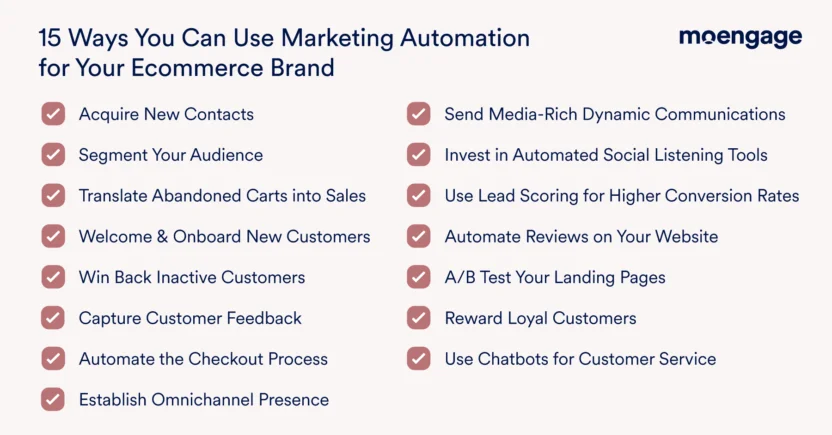
When done right, Ecommerce marketing automation becomes your secret weapon for building stronger customer relationships at scale. Let’s explore how you can level up your automation game and make your Ecommerce workflows work harder for you.
1. Acquire New Contacts
You can automate your marketing for Ecommerce to grow your contact list and attract new customers.
If you regularly produce high-quality, actionable, and insightful content, your audiences will be keen to hear from you. This situation can be an excellent premise for offering them something of value in exchange for adding their information to your email list. Typically, surveys, whitepapers, reports, and similar documents are available to those who sign up for a business newsletter.
Similarly, if someone makes a purchase on your online store, your Ecommerce marketing automation software can add their details to your customer database. Every addition offers granular insight into buyer profiles and helps discover commonalities, which you can later exploit.
2. Segment Your Audience
Segmenting your subscribers helps you increase sales by offering customers what they already want. You can segment your contacts to make lists based on various common factors like location, average order value, engagement level, age, profession, etc.
For instance, if you have two different types of newsletters for subscribers based on their interests, you’d have to create two different lists of contacts in your Ecommerce marketing automation software to send the right message to the right customers.
In fact, you can achieve several levels of segmentation via lists, tags, and custom fields to make your messages highly targeted and relevant to customers.
3. Welcome and Onboard New Customers
Like it or not, first impressions matter.
Nowadays, it’s a given that signing up on a website would trigger Ecommerce email marketing automation workflows that will welcome customers to the website. These communications can require explicit consent for adding the customer to the email list (we know, managing an email list isn’t easy), share an overview of the brand’s value or message, or guide them through the purchase process.
You can also lure the new accounts with promos and discounts that will get them swiping their card in no time!
A welcome series can also be particularly helpful in extending customer service for those who have already purchased your product or service. You can share details on how to use the offerings to extract maximum value. Such a consideration can boost customer loyalty and enhance customer experience.
4. Automate the Checkout Process for More Sales
A complicated checkout process can deter customers from completing their purchase, but you can prevent a large percentage of abandoned carts by creating a smooth and trustworthy checkout process.
With marketing automation for Ecommerce, you can fill in customer details automatically and display preferred payment options to make it as convenient as possible for customers to complete a purchase. You may also add a live chat option on the checkout page to swiftly answer customers’ queries during the buying process.
5. Translate Abandoned Carts into Sales
Cart abandonment is a serious problem in the Ecommerce sector. About 7 out of 10 buyers abandon products in their cart for various reasons. This figure varies depending on the device. As a result, cart abandonment can cost your online Ecommerce store billions of dollars in sales per year.
Fortunately, marketing automation for Ecommerce attempts to offset these losses through regular follow-ups and check-ins. Automatically triggered emails that hit the right combination of subject lines, email copy, and CTA could convince the shopper to buy from you.
6. Win Back Inactive Customers
Similar to cart abandonment, you could have customers who may have signed up on your online store only to forget about you entirely! Or you could have someone who made an occasional purchase and pulled the plug on their CLV.
Ecommerce marketing automation platforms can help in such instances. You can customize email marketing automation campaign workflows that deploy after a lapse of X number of days, offering the client coupons or promos to pique their engagement.
7. Capture Customer Feedback
Ecommerce brands that encourage customers to post their ratings and reviews against the products can improve conversion rates. In this regard, marketing automation software makes the task easier through automatic feedback collection.
You can implement email marketing automation for Ecommerce that prompts the buyer to share their customer experience after X days post-purchase.
8. Establish Omnichannel Presence
Consider a situation where someone has browsed through the products on your online store. This action indicates that they are either curious about the product or have considered purchasing it. That’s a lead right there.
Through Ecommerce marketing automation tools, you can reach the lead through other channels, say social media platforms, and test their responses. If they continue engaging with the ads, it is a clear indication that they are a qualified prospect. Automated workflows can then capture their details and continue nurturing them to the point of purchase. That’s the beauty of omnichannel marketing!
9. Send Media-Rich Dynamic Communications
Dynamic content refers to customizing your content for visitors. With dynamic content, the content and images on your pages adapt to customers’ in-session behavior, demographic data, and characteristics.
This offers two benefits. First, presenting relevant offers helps decrease bounce and increase conversions. Second, it allows you to create personalized experiences.
Including rich media, such as product images, can make a world of difference when you are re-engaging your leads. For our Ecommerce customers, we’ve seen product images improving their CTR for emails and rich push notifications.
It also offers great potential to cross-sell or upsell products on your online store. All you need to do is set up product blocks and let your marketing automation platform handle the rest. This form of content marketing automation for Ecommerce will share relevant details such as product specifications, price, and other crucial details that will be too tempting to pass up!
10. Use Lead Scoring for Higher Conversion Rates
An Ecommerce marketing automation platform that offers lead scoring can help you boost conversions by automatically sending personalized content to prospects depending on their position in the sales funnel.
Lead scoring can also be used for pre-qualifying leads before passing them onto your sales team by assigning a score to every lead based on their actions on your website and other predetermined factors.
Cold leads or those with low scores can be segmented further and nurtured with personalized content before passing them on to the sales team. For instance, as soon as a subscriber shows interest in buying from your Ecommerce store, you may automatically enter them into a drip campaign to slowly nudge them into completing the purchase.
You may set the following types of automated email marketing campaigns to nurture your leads and drive customer loyalty as well:
- An automated welcome email series for effective onboarding
- Follow-up emails to remain in touch with new leads on certain predetermined milestones
- Offer emails to encourage purchase
- Review requests for feedback and user-generated content (UGC)
- Abandoned cart emails to recover lost revenue
- Emails celebrating milestones and personal events
11. A/B Test Your Landing Pages
A/B testing refers to simultaneously testing two or more variants of a page to see which one performs the best. With your marketing automation Ecommerce software, you can quickly run such tests between your product pages and landing pages to make informed decisions regarding the digital assets you’ll use.
Some of the elements you may consider for split-testing are:
Headlines
- Compare a longer versus a shorter headline
- Ask a question in your headline
- Use a testimonial in your headline
- Try positive and negative emotions
Calls-to-Action
- Compare the use of words like “Free”, “100%”, “Bonus”, etc.
- Try different color combinations
- Placement of text
Banner Image
- Placement
- Color scheme
- Text on display
12. Invest in an Automated Social Listening Tool
With an automated social listening tool, you can monitor customer conversations around phrases, keywords, hashtags, and industry-specific terms. This will give you a holistic view of how customers talk about your brand and what they expect from it.
Some social listening tools are also equipped to run sentiment analysis on captured data to give you actionable business insights.
13. Automate Reviews on Your Website
Gathering customer feedback and acting on it is crucial to your brand’s success. However, manual collection of reviews can be a tedious job. Instead, you can set up trigger emails that are automatically sent to customers a few days after product delivery to ask for feedback.
You may even use web push notifications or in-app prompts to gather feedback and reviews for your products.
14. Reward Loyal Customers
Loyal customers buy more. With Ecommerce marketing automation, you can segment your best customers and reward them for their shopping behavior to boost customer loyalty and subsequent sales.
An automation program can also be set to convert first-time shoppers into repeat customers by automatically rewarding them with a special discount or promotion via email. Offering customers a coupon or discount code that applies to their second purchase is an excellent way to keep them coming back.
Under your loyalty program, you can offer flat discounts, exclusive offers, BOGO promotions, free gifts, and more.
15. Use Chatbots for Customer Service
Customer service is the focus of most Ecommerce brands and requires dedicated resources to tend to customers 24/7. This translates into a significant amount of revenue for any brand, which can be optimized with the introduction of chatbots in the front line of customer service.
But that’s not all. You can also use chatbots in retail and give your shoppers a highly personalized experience.
7 Ecommerce Marketing Automation Examples to Learn From
How can you improve conversion rates and other key metrics through marketing automation for Ecommerce? Nothing hits home like an example does.
So here’s a list of marketing automation best practices and strategies used by real-world Ecommerce brands to help you get the gist.
1. Nike: Customer Service Chatbots
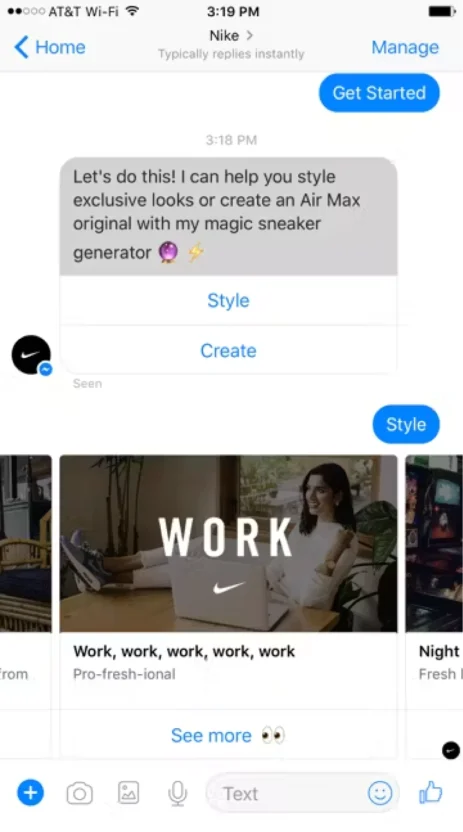
Source: https://www.producthunt.com/products/github-visualizer#nike-stylebot
As you can see in the above image, Nike StyleBot uses chatbots in retail and gives its shoppers a highly personalized experience. It helps customers style their shoes and browse previously uploaded designs for inspiration.
Shoppers can interact with Nike StyleBot on Facebook Messenger to mix and match, create their designs, and share them with friends, making the whole experience a lot more fun than usual.
2. Tattly: Reward Points for Every Purchase
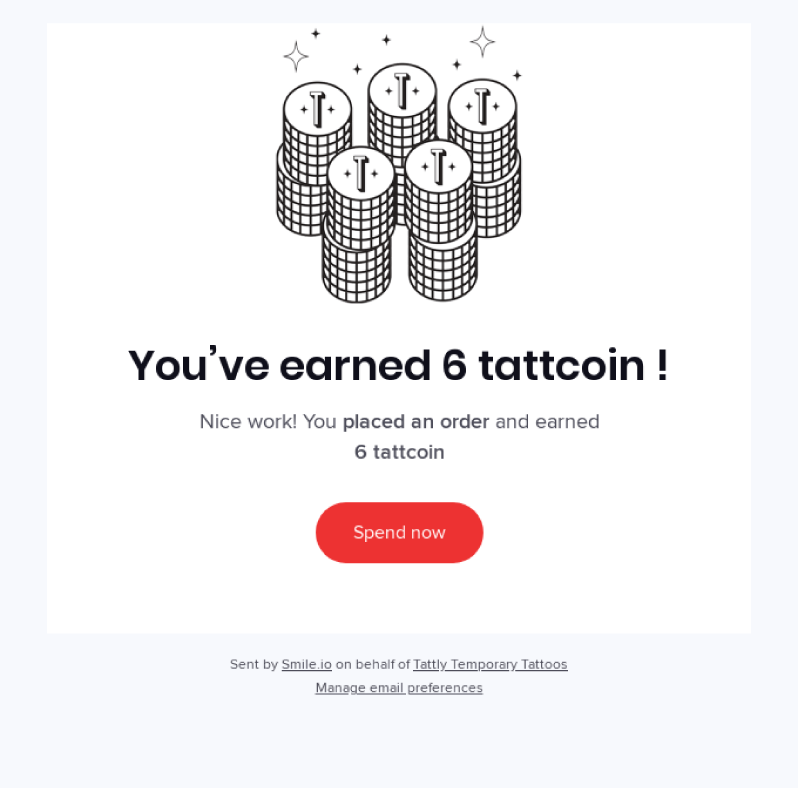
Source: https://reallygoodemails.com/emails/youve-earned-6-tattcoin-
Tattoo marketplace Tattly runs an automated point-based system that offers reward points for every purchase that can be redeemed on the site for discounts or other goodies.
Why is it such a good Ecommerce strategy? Because, c’mon, who doesn’t like discounts? As you’d agree, customers who buy the second time are even more likely to return for the third time, and so on. Incentivizing subsequent purchases through carefully crafted reward programs, like Tattly does, is an excellent way of building loyalty and promoting sales. It’s a clever way of using a marketing automation software platform!
3. Belgian Boys: Ecommerce Marketing Automation with a Win-Back Email
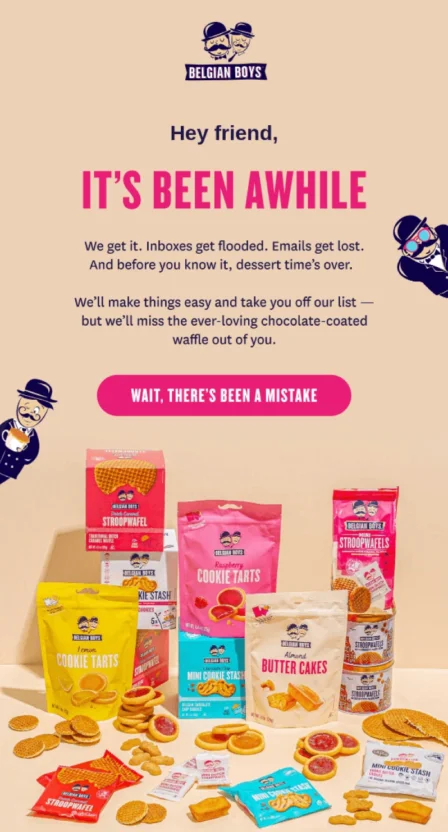
Source: https://reallygoodemails.com/emails/we-miss-you-belgian-boys
Belgian Boys, an NYC-based breakfast item brand, uses email marketing automation software workflows that deploy after a certain number of days have passed without any action from a customer. Given that the account has already gone cold, the brand has nothing to lose, right?
That’s what they thought when sending this automated email. The copy’s dripping with food-related metaphors that make the reader lick their lips and think twice about leaving the brand forever.
Plus, instead of boring CTAs like “Shop Online” or “Order Now”, the CTA “Wait, there’s been a mistake” is pretty conversational, which makes it all the more fascinating and click-worthy. It gives off a feeling of mystery — the customer is left wondering what’s going to happen next, so they’re tempted to click the button.
4. Airbnb: Request Customer Feedback
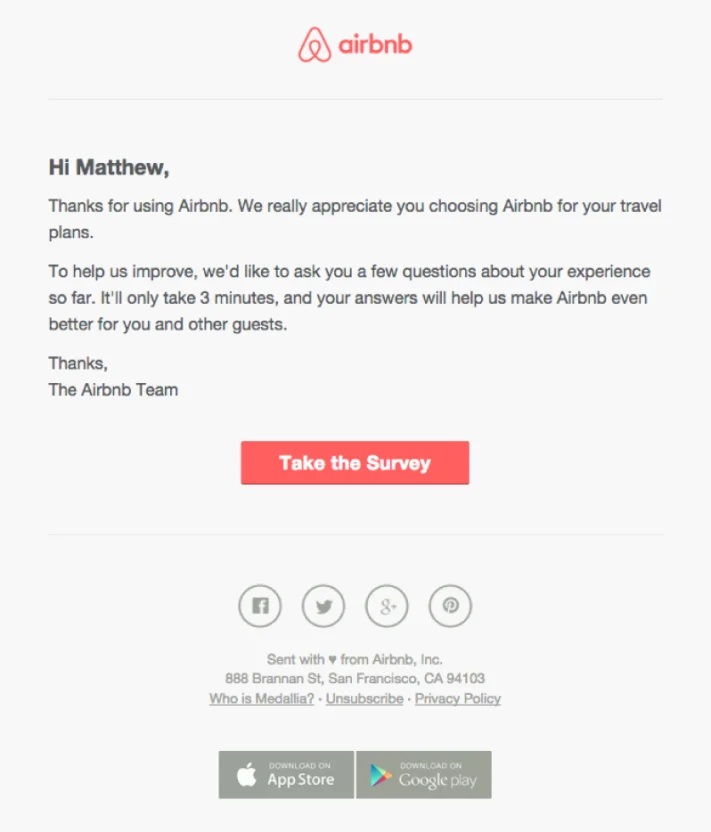
Source: https://reallygoodemails.com/search/emails/airbnb
First of all, customers seeing a warm and friendly subject line like “We’d Love Your Feedback! It’ll Only Take 3 Minutes” can’t help but open the email.
As you can see, this automated email from Airbnb encourages customers to share their feedback about the brand—a chance for them to improve conversion rates. Ecommerce marketing automation software helps them implement email automation that prompts the buyer to share their experience after a certain amount of time following their purchase.
5. Warby Parker: Automated Shipping Confirmation Email
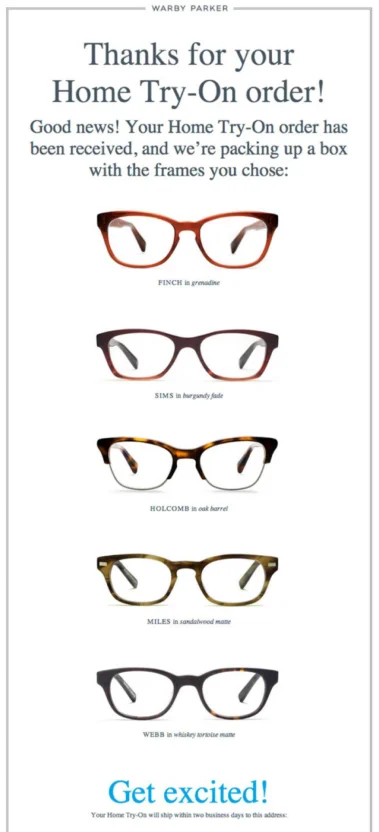
Source: https://reallygoodemails.com/emails/transactional-update-email-design-from-warby-parker
Warby Parker sends this email when a customer’s home try-on glasses are shipped. Okay, cool. The customer knows that their order is on the way, and they can track it. They can also verify their address as mentioned at the bottom of the email.
But you know what sets this automated email apart? It thanks the customer. And don’t miss the playful “Just for you” heading and the sentence congratulating the customer on choosing to try on the glasses at home. All of that’s a humble way of acknowledging that the customer is important for their brand.
Because transactional emails, like this one, get high open rates (who doesn’t want to know when their order has shipped?), Warby Parker knows they can drive a ton of traffic and get sales if they include a few strategic CTAs.
6. Dyson: Abandoned Shopping Cart Email
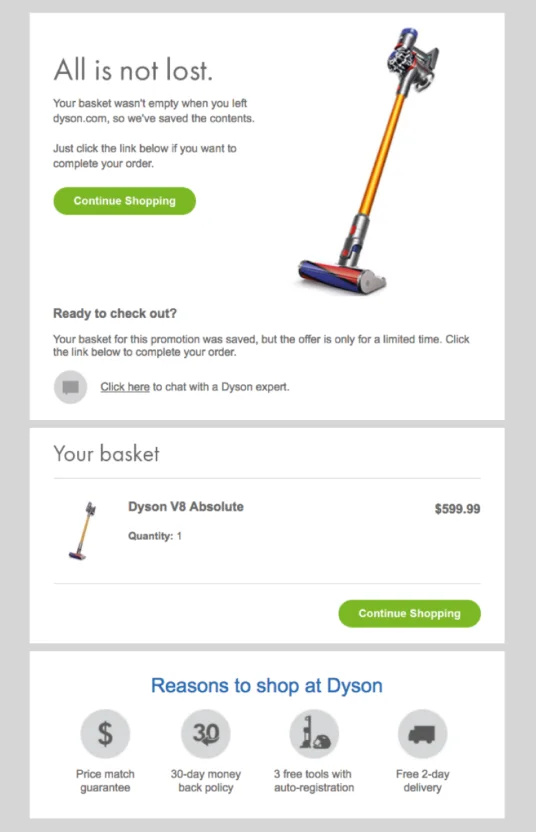
Source: https://reallygoodemails.com/emails/items-in-your-basket-at-dyson-com
Life is hectic, and customers are fickle. There are a thousand reasons why customers don’t finish the checkout process, and Dyson knows that. Sending them this gentle reminder is a surefire way to not only show them that Dyson cares about them, but also coax them to finish what they started.
7. Patagonia: Welcome Email Automation
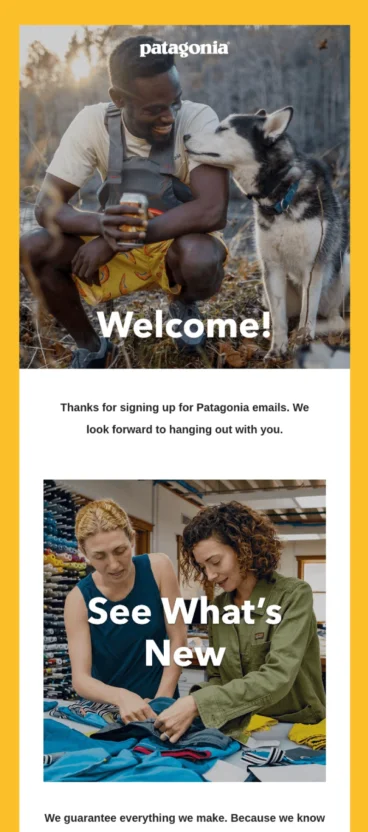
Source: https://reallygoodemails.com/emails/welcome-to-patagonia-emails
When a customer signs up for Patagonia’s emails, they’re immediately welcomed to the email list, with the promise of all types of useful content.
And guess what? At the bottom of the email, Patagonia includes a lot of different calls to action (CTAs). When customers click on those, they’re already telling Patagonia what they’re interested in before they’ve even purchased anything. Smooth, right?
5 Best Ecommerce Marketing Automation Software to Increase Engagement
Below, we’ll walk you through five of the best Ecommerce marketing automation platforms. We’ll break down what makes each one shine in its own way, where they might fall short, and give you pricing insights to help you pick the right fit for your Ecommerce brand.
Let’s get right into it.
1. MoEngage
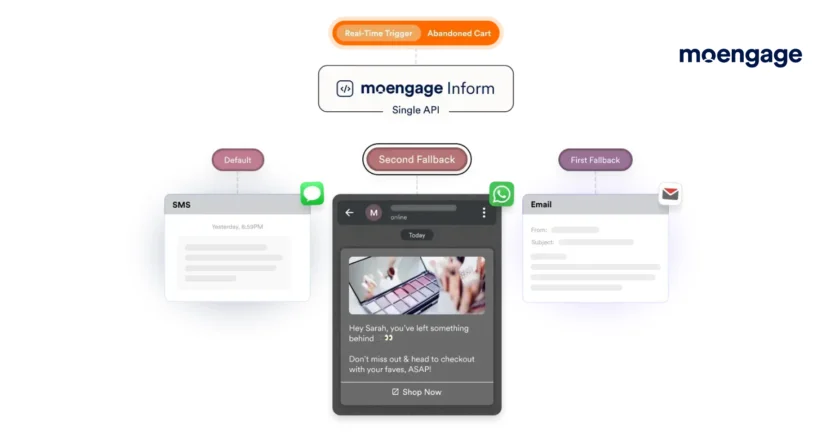
MoEngage is one of those rare platforms that makes tech advanced enough for enterprise brands while still being friendly for mid-sized Ecommerce teams. It’s an all-in-one customer engagement platform combining push notifications, in-app messaging, SMS, email, and more—all tailored for customer lifecycle management.
Its standout feature? AI-powered Ecommerce personalization. MoEngage uses machine learning to analyze customer behavior and predict what they might be interested in buying next. For Ecommerce brands, this means you’re not just spamming offers, but landing in their inbox or notifications with exactly what they’re most likely to purchase.
How Pricing Works: Plan details vary based on the features your brand needs. Request a custom quote for enterprise-level flexibility.
Best For: Ecommerce brands looking for cross-channel marketing automation and predictive audience segmentation with intuitive workflows.
2. BigCommerce
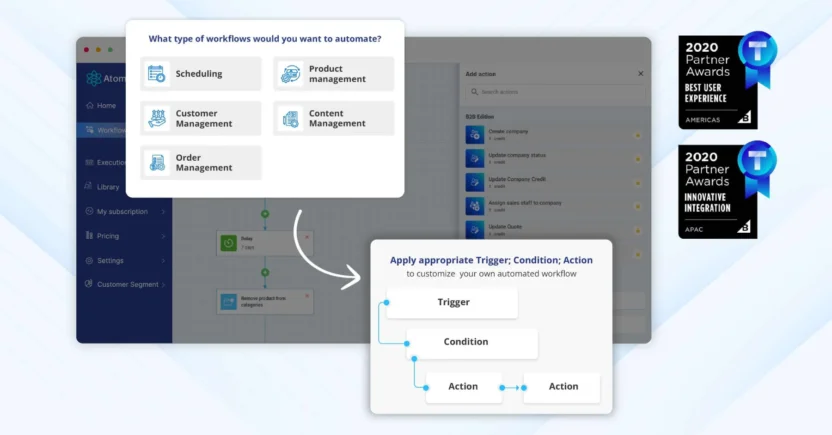
Source: https://www.bigcommerce.com/apps/atom8/
BigCommerce is an all-encompassing Ecommerce platform with features to build, run, and grow your online store.
That said, because it’s primarily a platform to build and manage your Ecommerce website, its marketing automation workflows can sometimes feel limited compared to those in tools like MoEngage or Omnisend. That’s because BigCommerce doesn’t offer automation on its own platform; you need to integrate GritGlobal’s Atom8 Automation to optimize your online store.
So, if you’re neck-deep in email workflows and need automated email drip campaigns, for example, BigCommerce might not check every box.
How Pricing Works: Their pricing is tailored to each client’s needs, depending on the growth stage they’re in.
Best For: SMBs and mid-market businesses looking for a do-it-all Ecommerce platform with baked-in automation for basic marketing needs.
3. Omnisend
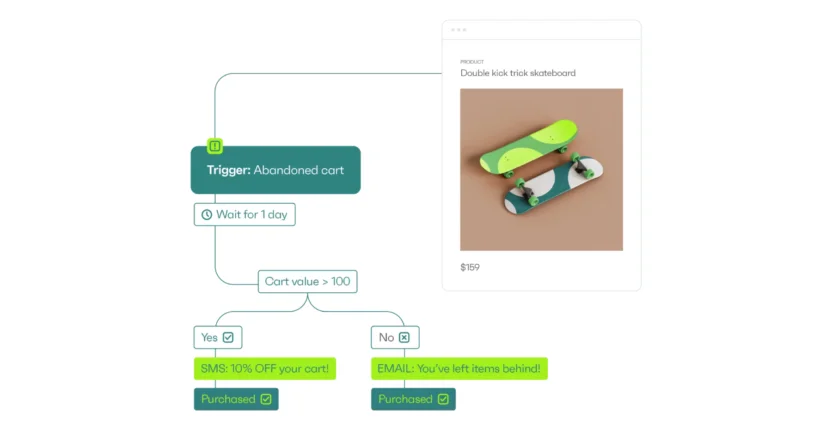
If email marketing is your bread and butter, Omnisend may just bake you a second loaf. Designed specifically for Ecommerce marketers, Omnisend combines email, SMS, and push notifications to engage customers at every stage of their journey. Its pre-built, Ecommerce-specific workflows (hello, abandoned cart recovery) are built to save you hours of setup time.
The magic lies in its deep integrations with Ecommerce platforms like Shopify, WooCommerce, and BigCommerce. Omnisend’s segmentation features are also worth shouting about. You can easily target customers based on behavior, past purchases, and even how much they’ve spent, so your messaging is as relevant as possible.
Where might it fall short? Limited flexibility in cross-channel campaigns (beyond email, push notifications, and SMS).
How Pricing Works: Omnisend offers a free plan with basic email automations for 500 contacts. Plans scale upwards based on email list size and features.
Best For: Ecommerce brands working with smaller teams but seeking powerful email/SMS automation without the hefty price tag of more enterprise solutions.
4. Rejoiner
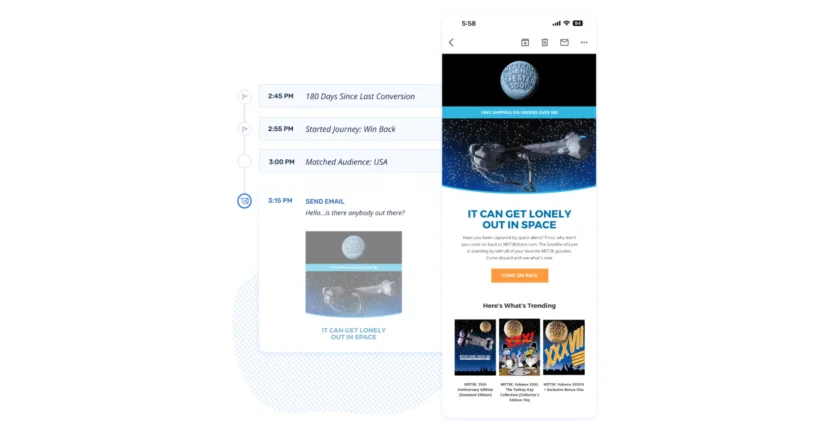
Rejoiner is at its best for one thing and one thing only: reducing your cart abandonment rates.
If your Ecommerce brand is losing more customers than it wins at checkout, this platform can help you build laser-focused campaigns to bring those shoppers back. Its predictive revenue tracking ensures you have clear visibility into how much money is at stake and saved with each abandoned cart workflow.
The downside? It’s not an apt tool for cross-channel marketing automation. If you need broader automation beyond email, like SMS, in-app, or push notifications, you’ll need to integrate it with other tools or run them separately.
How Pricing Works: Rejoiner’s pricing ranges between $25/month for 1K contacts and $1,695/month for 149K contacts. It offers custom pricing for a list of over 150K contacts.
Best For: High-traffic Ecommerce brands laser-focused on maximizing revenue recovery from abandoned carts.
5. ShipStation
At first glance, ShipStation might seem like an odd pick for a list of Ecommerce marketing automation tools. But hear us out.
While it’s primarily a shipping software solution, it earns its spot here because of its lesser-known post-purchase automation tools. You can delight customers with personalized shipping confirmation emails, branded tracking pages, and upsell offers strategically placed in delivery notifications.
If you’ve ever wanted to strengthen loyalty and cross-sell opportunities after someone completes a purchase, ShipStation’s workflows can be a game-changer.
However, it’s not built for pre-purchase interactions. If you’re looking to create in-depth automation around acquisition, consider other platforms in this list first.
How Pricing Works: Plans start at $9.99/month for smaller businesses and go up to $399.99/month for advanced features and higher shipping limits.
Best For: Mid-to-large Ecommerce brands looking to enhance post-purchase customer engagement and improve the customer experience.
Why Omnichannel Beats Multichannel Marketing Automation for Ecommerce
Multichannel marketing automation fails to deliver a cohesive experience. It gets your messages across different platforms, but the messages are disconnected. In contrast, omnichannel marketing automation is about connecting the dots so every message feels like part of one big, seamless experience.
We know you’ve already heard enough on the omnichannel vs. multichannel marketing debate. But seriously, it gets more interesting when you stop and think about it.
Picture this: a customer clicks on a product ad on Instagram, later gets an app notification with a discount code, and finally receives an email reminding them the item is almost sold out. Each touchpoint builds on the last, creating a smooth, personalized customer journey. That’s how omnichannel marketing automation works.
Take Nordstrom, for example. Added something to your online cart? You can pick it up in-store the same day. Every interaction, whether it’s an email, a notification, or an in-store visit, feels like part of the same story. A multichannel approach might stop at sending a single email for an abandoned cart.
Whether you’re doubling down on omnichannel and cross-channel engagement with MoEngage, building loyalty post-purchase with ShipStation, or maximizing abandoned cart recoveries with Rejoiner, the key is finding the right fit for where you are and where you want to go.
Set Up Ecommerce Marketing Automations with MoEngage
MoEngage lets you create seamless, personalized customer journeys that feel more human. From AI-driven insights to tailored message automation, it’s built to keep your audience engaged at every step of their Ecommerce journey.
Ready to step up your Ecommerce marketing automation game? See MoEngage in action.














